JAGS Wonderland by DNA Cowboys
The walls of reality have cracks in them. There are cracks in the world.
Original SA post JAGS Wonderland: The walls of reality have cracks in them. There are cracks in the world.There’ve been several yea-votes for Wonderland , so that’s what I’ll be exploring for the next several posts. This is another game on the “obscure” side of the line. The art and the system are closer to mockable, but there are so many mad, beautiful ideas that I hardly care. I’d use Don’t Rest Your Head or Unknown Armies , or, if it were the only way my group would agree, Savage Worlds . Wonderland and its one supplement, The Book of Knots are available for free and use JAGS: Just Another Game System . The game has an implicit metaplot, although it can be ignored. Still, expect spoilers.
The book's available as a free .pdf or as a hardcover with suitably creepy art. Read along if you like!
As Kestral pointed out, Wonderland 's very much in the urban fantasy and occult madness vein; however, being written in 2005 gives it some advantages. Not only does it do dark Alice in Wonderland without coming off as pandering, it balances the Alice elements with so much else that the game ends up being something else entirely.
After all that gushing, let’s move on to the first of 238 pages:

Oh. God.
There’s no cover for the .pdf, just this… thing. Then it’s a title page, several pages of contents, Sir John Tenniel’s Jabberwock, and three pieces of introductory fiction. They give a broad overview of what we’re getting into, so I’m going to spend some time on them.
The first piece is a metafictional dream wherein the reader (me!) meets a girl named Alice who’s reading from a book called JAGS Wonderland . She reads out loud, explaining the book, then stops. “All this talk about ‘themes’,” she says. “They make it sound like a Literature lesson.”
Breaking from the script, she gets to the point. “Wonderland is about madness,” she says then, picking up a cup of tea and sipping daintily. “Wonderland is about living in a world that seems normal on the outside but is full of worms and horrible laughter and empty halls and doors to nowhere and upside-down staircases underneath. Wonderland is about an infectious, predatory, alternate reality.”
She continues: Reality is broken into eight chessboards. It isn't clear at this point, but they function like layers on an onion--or Photoshop layers--for a while. Then things get really messed up. The world we recognize is Chessboard Zero. “But as you go further and further down things get stranger and stranger. And the things down there get stranger and curiouser and curiouser and, well you know.” Alice is very vague, as this is a game with Mysterious Secrets and this is only the introductory text. Cast your bets, we have a long way to go!
The second fiction (“The Second Warning”) takes us to 1958 New Mexico: “A hundred and fifty feet of sterile blue-steel vertical shaft beneath the desert leads to a 155,000 square foot environmental pod built in a natural air pocket in the bedrock.” A top secret government research team called Project Pilgrim is bustling around. They’re made up of “linguists, mathematicians, psychiatrists, and physicists.” They’ve made contact with an unexplained radio signal. Is it aliens? Is it the Soviets? Whatever it is, it’s intelligent. Too intelligent.
The scientists of Project Pilgrim are like lab rats and children to this... thing that eventually becomes known as the Red Queen. Everyone who talks to “her” ends up developing hallucinations. Everyone who talks to them? Same deal. Intermittent psychiatrist reports show the descent into madness: “Is it playing games with us? […] I’m working on a full-scale evacuation plan. […] It’s a lot bigger down here now and I’ve gotten lost several times. I realize that doesn’t make any sense. I hear the music so they’re calling me to the playroom. I’d better go. If you start hearing carnival music up there you’re really in trouble. This is probably my last report. There are things in the mirrors Im afraid of.”
The epilogue informs us that Project Pilgrim was infected. Compromised. Its secret power brokers try to shut it down. Do the 5-7 survivors (out of 37) kill themselves to end the vector or turn on their handlers and just go deeper down the rabbit hole? #2, naturally. They become Project Puritan. More on them later.
Sidebars inform us that Lewis Carroll and Walt Disney knew too much. Wonderland is coming.
The Third Warning is a more personal piece about a down-on-their-luck couple. They don’t know what to do with their lives so they play around at occult games involving mirrors and have kinky sex. One day, the man sees a rippling rainbow fish behind the bulging skin of a mirror. It tells him its plan and it changes him. Warps his mind. He proposes to his girlfriend, then leads her to the mirror. It does not end well for her. See Figure 2.
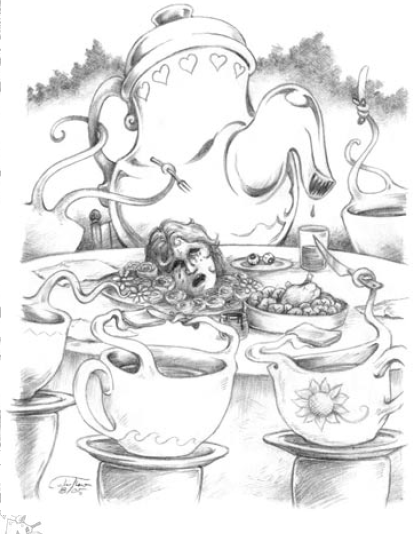
Finally, the .pdf offers one final warning:
One Final Warning posted:
JAGS Wonderland is a world book for a reality that is starting to unravel and in the dark spaces where the threads have come apart are candy-colored nightmare eyes. It’s horror in the traditions of the Silent Hill computer games. Cinematically it draws from Hell Raiser (itself somewhat derivative from the Alice in Wonderland books—ask Project Puritan) and Jacob’s Ladder . It’s informed by the phantasmagoric works of Lewis Carroll which any child knows are scarier than they are whimsical, darker than they are humorous, and, as American McGee realized with his wonderfully gothic Alice video game, far more mad than either the Hatter or the Hare.
Characters range from normal people caught up in the madness to paranormal investigators to military operatives or even experienced journeyers in the far realms of human existence. How you decide to play will determine which rules you focus on but whatever you do, we hope you like it.
Wonderland is Coming.
Next: You are CONTAGIOUS: Making Unsanity Fun.
Making Unsanity Fun
Original SA post JAGS Wonderland: Making Unsanity FunLast time, we learned that JAGS: Wonderland is (probably) an urban fantasy/occult madness game about an alien reality invading the one that we know and love. The introductory fiction was coy about specifics. Now we get to the introduction, proper. One of them, at least. There's another one right after this section, which isn't as confusing as it sounds. The constant introductions are like guideposts, separating what GMs should know from the lies they tell their players.
The introduction is written in objective GM-speak. Unlike most of the text, which hints at riddles that aren't fully answered until later on, it shoots straight. The introduction tells us that Wonderland is an "infectious, predatory reality." The universe, as we know it, consists of eight "chessboards." Chessboard Zero is the reality that makes sense: Starbucks, World War II, and guinea pigs. That kind of stuff. "One level down, most of the pieces are the same but some are different. Some are monstrous. As you go further and further down you wond't recognize any of them at all." Becoming exposed to Wonderland infects you and pulls you deeper into the lower chessboards.
Certain people are able to handle Wonderland infection better than others. They aren't heroes, but they are more open-minded, pragmatic, or able to "get it together." In the case of PCs, they will become heroes... if they survive. One trait all these characters share, if you're playing everything by the book, is they've been diagnosed with the hottest new pop-psychology condition: Cyclic Psychoaffective Disorder. End introduction.
CPD hasn't been officially recognized. People say it's a communicable psychological illness: it can be spread through verbal, written, or electronic contact. People say that mainly college students and drug addicts get it. It causes hallucinations and nightmares. Is it aliens? The government? No one knows anything, but your health insurance isn't going to cover it. The only place to go to get help is the Underground.
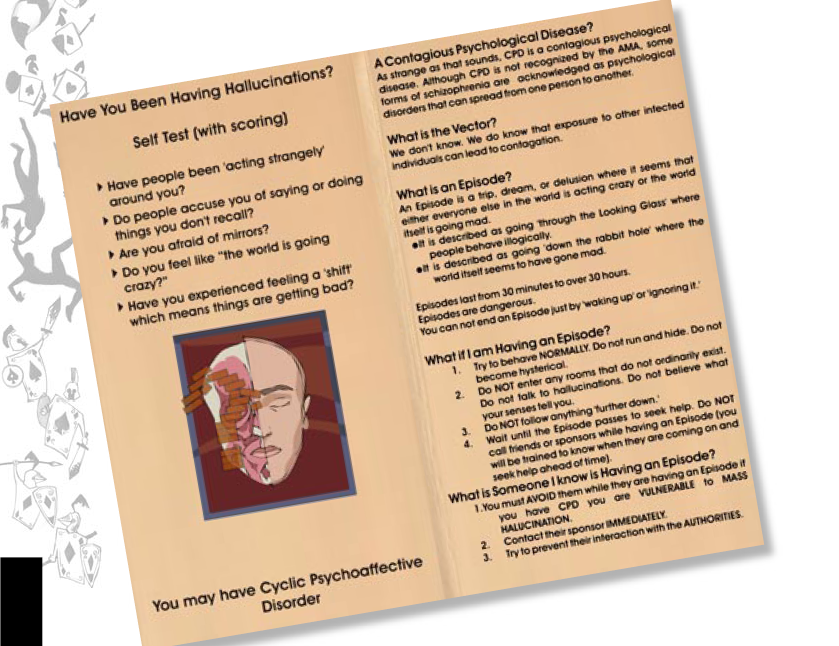
The Underground is a New Age organization patterned on a 12-step program. People who need help find it through message boards, head shops, graffiti, and other undergrad hangouts. They're big on sponsorship, rigid rules, and accountability to one another. The medical establishment is a sham, the government is untrustworthy, and only other sufferers of CPD can help support one another in their time of need. There are different factions with different levels of political engagement, but generally they're on the look out for events that trigger members' CPD hallucinations and urge them not to explore the "doorways" they imagine. People who go down those imaginary rabbit holes don't tend to get better.
Then we get a piece of fiction about attending a typical Underground meeting. Afterward, Mooney, the head of the group, takes you (the reader) to a private meeting with Dr. Shatter, a therapist who started believing in CPD after he was infected. Shatter warns us the government is prepared to take dangerous measures to shut down a contagion of this magnitude.
Then we take a ride to meet Miss M, a stressed woman in her 30s. She's into tarot and incense. Miss M isn't fond of therapists, or as she calls them, THErapists.
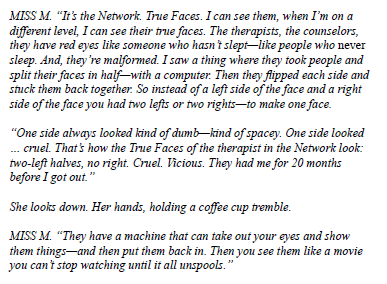
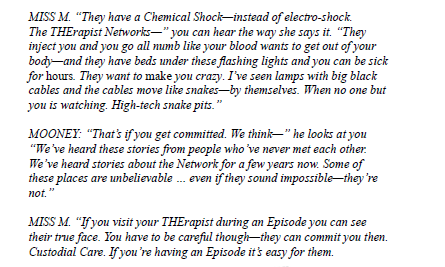
During her episodes, Miss M says she can leave her body while having a CPD episode. During this time, she bites a THErapist on the foot and he dies. Her body can do bad things, but it's on a different level. Miss M is not what one would call a reliable narrator. She starts having an Episode and Mooney freaks out. Weird thumpings start coming from throughout Miss M's house. Something big is coming. Miss M speaks nonsense. "The air in the room goes hot and raspy. -- The End."
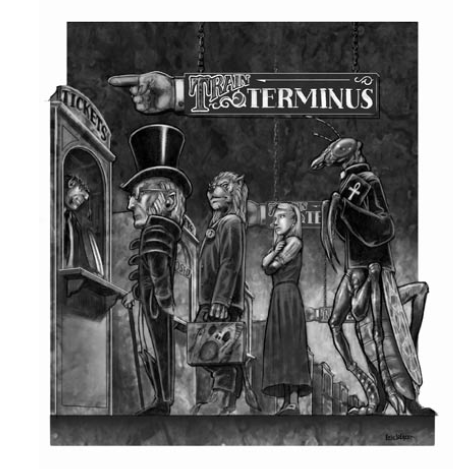
This picture isn't explained, but it's a weird contrast to the nails-on-palms action of the previous story and the college-day depression of CPD. What else could be in store for us?
Next: The One-Minute Guide to Wonderland (Chessboards Included)
Welcome to Wonderland
Original SA post JAGS Wonderland: Welcome to WonderlandIf your next question was how should a group handle Unsanity in play, the book has you covered. Before getting into the nuts and bolts, we're informed: " JAGS Wonderland is a surreal game of personal horror: it's a game where in the basic format your character is Infected by Wonderland and goes insane --well, Unsane , because it's really real and it can really kill you."
Surprise!
The book goes back and forth on how much knowledge the players should have going into the game. Do they know they're creating college students for a game of personal horror where they have a contagious nightmare disease? Do they know they're being swallowed up by an alien reality? Do they know their delusions are real? I'm just telling it how the book does: muddled, but jam-packed with mad ideas.
When you have a CFP episode, you're slipping between the cracks in reality to a lower chessboard of existence. It's kind of like this:
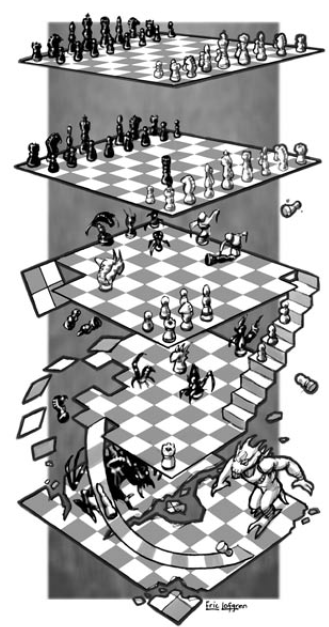
Only a reflection of your physical body stays behind while you're down there. It reacts exactly like the you-traveling-the-chessboards. In other words, it's having conversations on everyday Earth with people who aren't there, responding to stimuli that doesn't exist. Players are encouraged to talk with their GM about how to handle this disconnect:
1. Hose me pretty badly. (Have my unsanity ruin my life. I need to explore the social impact of insanity at its most
 )
)
2. Make sure there's a safety net. (Do terrible things, but I don't want to end session one lobotomized in a padded room. This is the default mode.)
3. Don't seriously mess up my character. (Focus the game on other areas than unsanity complications.)
4. Let me decide. (That hippie story-gaming that's all the rage these days.)
Too much GM control here can be disempowering. The text points out that this can be a good thing in a horror game, but it really comes down to comfort levels and talking things out beforehand. Episodes don't have any fixed length, so going with "Hose me pretty badly" is asking for trouble.
As a quick review of the hints and pieces teased so far, we get eight bullet points in a atmospheric, faded typewriter font:
1. Reality is composed of eight chessboards. We live on Chessboard Zero. Everything underneath? Wonderland! It gets weirder the deeper you go.
2. Wonderland is hungry. Wonderland is infectious. Why would you want to go there?
3. There are cracks in the chessboard. Sometimes things from Wonderland seep into Chessboard Zero. They infect people with Unsanity, turning them into Carriers of the Wonderland Infection. They infect other people, dragging them down into Wonderland. PCs tend to survive longer than everyone else.
4. Being Unsane means you undergo Descent. Descent means you drop down one or more chessboards. It's like a trip or a delusion, only you're physically transported.
5. You can meet things that look and act like people you know on lower levels. People on Chessboard Zero cast Shadows down to lower layers.
6. Your Shadow acts like a crazy version of you. They act like a caricature of you or the archetypal version.
7. When you undergo Descent, you cast a Reflection up to Chessboard Zero. Your Shadow gets catapulted up to Chessboard Zero and takes your place for awhile. He's still shadowing you though, copying your moves and words in an exaggerated fashion.
8. There's a lot more. "That's enough for now." But I want to go on! Next, the Chessboards!
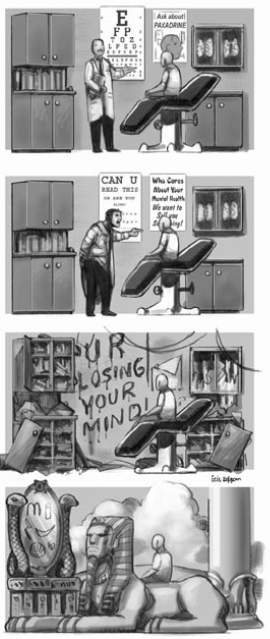
This picture illustrates the same room across the first four Chessboards: Zero, One, Two, and Three. Here's what we get for now:
Zero: "It's a nice place. Good neighborhood. Law abiding, if you know what I mean (As in, the laws of physics.)"
One: Not too weird. It looks just like reality as we know it, but it's populated by Shadows instead of real people. While you're down there, you're interacting with bizarro caricatures of real people; up on Chessboard Zero (the "real world"), those people are interacting with your bizarro Reflection who's aping your interactions with their bizarro caricatures. Hence, you appear all kinds of insane. Also, "printed material says what it really means ] instead of what it says in real life. Right. Like that movie. Right--but without the sunglasses."
Sidebars advise the GM to spend a lot of time in the first two Chessboards. A whole campaign can be spend dealing with government conspiracies, the Underground, monsters, subtle, personal horror of Chessboard One, cults, etc. But there's more!
Two: You're getting into Silent Hill territory. It looks like the "real world", but everything is trashed and abandoned and looted. There are monsters. There are worse things than monsters. Some areas are bizarrely mutated.
Three: The weirdness begins. It seems like anything goes here: floating islands inhabited by dwarves, etc. However, the major landmarks correspond to important areas on Chessboard Zero, changed to reflect their inner nature. For example, malls are Cathedrals to Consumption packed with fanatics. (Giant frozen chicken fanatics or otherwise)
Four: Human concepts become concrete. You can mine virtue and get a start on the inspiration-smuggling trade. The landscape changes every hour, on the hour.
Five and Six: Described in much greater detail later. Off the edge of the map for the time being.
Seven: Babylon. Discordant energy. The sub-basement of the universe. Off the edge of the map for the time being.
Next up we have lots of examples on how to handle episodes, mechanics, and logical inconsistencies, so I'm going to call it a night.
Next: A Hot Bleed
A Hot Bleed
Original SA post JAGS Wonderland: A Hot BleedLast time, we learned about Cyclic Psychoaffective Disorder and how it's a sham. An alien reality called Wonderland is infecting people, pulling them down into lower levels of reality, and (occasionally) returning them to spread the infection.
The next part of the .pdf, Wonderland Terminology, repeats a lot of the information it's already provided about attacks of Wonderland Unsanity. The infected have trigger events (strange graffiti, mirrors, social anxiety) that send them down "rabbit-holes" to different chessboards/layers of existence. Reality as we know it is encompassed by Chessboard Zero. When you go down to Chessboards One through Three, the shadow-you who lives on those levels is sent up to Chessboard Zero as your representative in the real world. This leads to problems or hijinks.
One more note about shadows: if something bad happens to someone's shadow, it influences what happens in the higher-level chessboards. Let's say you find your boss's shadow on Chessboard Two, the Silent Hill dimension. You hit him with a truck. On Chessboard Zero, your boss has a day full of bad luck. If you hit him with the same truck on Chessboard One, the link would be tighter: he'd trip and break his arm, and probably be nervous around you for a few days. Shadows regenerate, leading to all sorts of torture games and power-plays that influence Chessboard Zero.
The Underground (AA for people who believe in CPD) encourages the infected to have a network of buddies and sponsors. During their episodes, they're supposed to touch nothing, respond to nothing, and repeat mantras ("There's no place like home. There's no place like home.") This is a bad strategy when there are hungry (or mean!) Wonderlandians about.
Sometimes, after spending enough time outside of Chessboard Zero, you get noticed. Things follow you back. They look like monsters if you get deep enough, but on Chessboard Zero, they take more familiar forms like semi-trucks or flashes of light. Unless you're alone. Or they're really hungry. Anyone who runs into these monsters is likely to become infected. Other ways to become infected: asking too many questions about CPD, being near someone with CPD when they suffer catastrophic descent (being sucked into Wonderland so powerfully that they don't get a shadow to replace them -- they just disappear), and experiencing a mutated form of the core infection. These mutations can be spread through mass media (like test patterns) or attained through years of mystical training.
Certain actions increase the chance of being noticed. The most interesting one ("Refusing to participate in a 'Drama'") isn't explained until later. For now, it's enough to say that it is the exact opposite of what the Underground encourages people to do: don't get involved. They're only delusions. That terrifies me: first off, the expected authorities (doctors, the government) fail to acknowledge the delusions. Secondly, the grassroots support network is spreading deadly misinformation. Thirdly, you get superpowers based on how crazy you are. That's proper meat for a new post.
Me & My Shadow
Original SA post JAGS Wonderland: Me and My ShadowAt this point in the .pdf, it starts hinting at the cool powers that you can get after being twisted by Wonderland. This causes intense physical change on every Chessboard below Zero. The list of powers don't show up for another 100 pages, but I always flip to them when I get to this point. Most people fall apart after being twisted; I imagine that "fall apart" and "twisted" are usually literal. However, PCs are made of stronger stuff:
quote:
But in other cases, being twisted by Wonderland makes us into something greater than we were. It infuses us. While many people are simply destroyed, "mutilated," or undone by twisting, a few--the kind of person who manages to survive initial infection--are actually enhanced by it.
No idea why "mutilated" is in quotes.
Characters who are in control of their Wonderland infection can use their twisted powers (through their shadows) to influence Chessboard Zero. Depending on the level of control, this manifests as synchronicity ("The door just fell off its hinges. It must've been old,") barely plausible correlation ("He started pounding on that steel door. His hands turned to hamburger, but somehow he got through it,) to superhuman ("Yep. He Hulked out.")
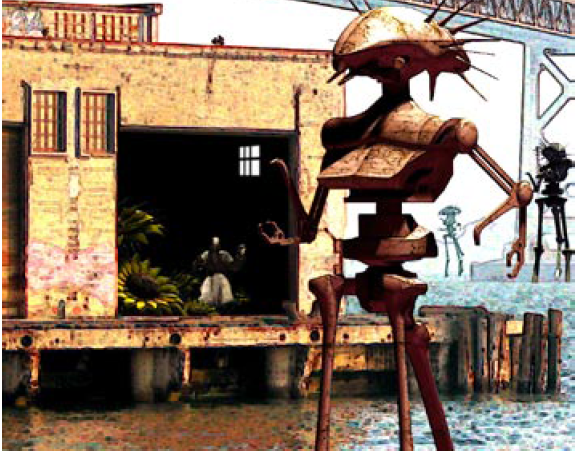
At least that's how it happens if your shadow is able to ape your actions while you're in Wonderland. It tries as well as it can, but moving too far too fast, being restrained, or dealing with totally out there situations can send the shadow into Reflective Disassociation. That's bad. The shadow will suffer a complete breakdown, probably after rushing into a taxi/stealing a car to try and stay in sync with your location. If you're too far from your shadow's location when you return to Chessboard Zero, you may end up being launched somewhere that physically corresponds to where you just left--or the middle of a cornfield in Iowa.
Letting shadow-you ruin your reputation while you're being chased by skin-grinders doesn't appeal to a lot of players. Some of them probably came up with the idea of arranging to have their shadows killed as soon as an episode started. Luckily, there's a sidebar explaining five reasons why faking one's own death isn't so easy. For example, if your episode only takes you down to Chessboard One, you're too close to to action. The shadow of the person you hired to kill your (regenerating) shadow will walk up and shoot you (who doesn't regenerate.) The deeper you get, the less it hurts.
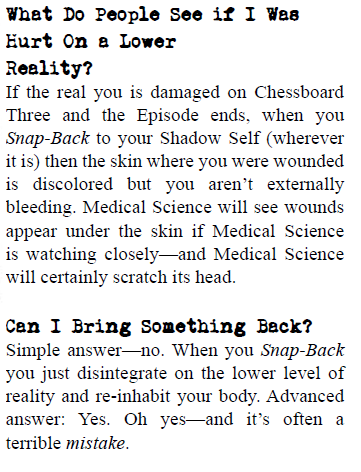
I'm not going to build an entire character, but I do want to show off the powers. Give me three well-known characters or archetypes who would attend a dodgy meeting for a possibly fictional disease, and I'll twist them up.
Sample Characters
Original SA post JAGS Wonderland: Sample CharactersBeing sucked down the rabbit hole doesn't just warp reality: it can warp you! Maybe you fall down a long shaft and have to be put back to pieces. Maybe you eat an innocent-looking cake that has a label that reads "eat me." Maybe a mad surgeon operates on you. No matter how it happens, 1) you survived because of something in your personality that adapts to Wonderland, and 2) you have cool powers.
This doesn't necessarily happen all at once. Each Twist is a turning point--or at least an exciting time.
Generally, these powers (and deformities) don't impact you until you descend to Chessboard Two. You can try to call on them while higher up (even in Chessboard Zero), but it will take skill. A fairly common technique to influence Chessboard Zero is to travel to Chessboard One and briefly manifest one's Twists. In the example given, a sharp-tongued man descends to Chessboard One so he can manifest his razor tongue to deal with some goons following him. While he shreds the goons' shadows on Chessboard One, his shadow defeats the goons with synchonicity: he breaths on them and they get ill, he gives them a verbal tongue-lashing and they trip in rage, etc.
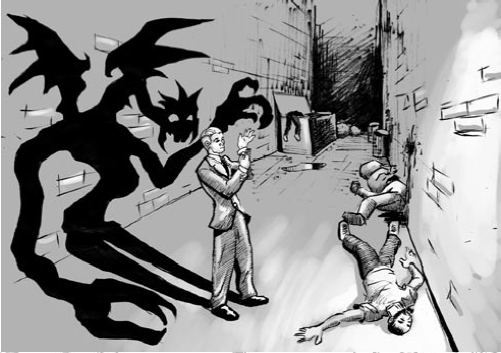
The rules offer us some advice about pacing Twists. They're the tools by which the PCs transform from the prey into the predators, so be aware that as characters gain Twists the tone of the game will change from horror to something else. One possibility is to introduce Twisted Points in drips and drabs as the story demands.
The book also warns against using twists to make characters who are complete emotional wrecks. When the going gets tough, they should be able to pull together and solve problems--unless that's the kind of game you want to play.
The three characters (plus one) that I've Twisted below are all made with 16 Twisted Points -- they're Weak Twisted Characters. Standard Powerful Twisted have 32 points, while Extremely Powerful Characters have 64.
Count Chocula posted:
Ed Norton at the start of Fight Club, Nick Cave, and one of my ultra gullible hippie friends who always repost Alex Jones articles.
Steve , the conspiracy theorist libertarian hippie has been twisted. He takes:
Barb (6). The character likes gossiping. His body grows thorns like a rose, each strong enough to penetrate armor. Naturally, the thorns are poisonous.
Jumping Legs (3). The character is prone to make snap judgements and make conclusions with miniscule amounts of data. He gets frog or digigrade legs that are good for jumping.
Snake Eyes/Spit Venom (4). You feel like the world has treated you unfairly. There's a problem with the "system." The character can see in the dark and spit globs of poison that take a while to recharge.
Spaghetti Limbs (1). You have feelings of powerlessness. Your arms and legs are five-yard long fleshy tentacles. Your movement is a sort of rolling crawl.
Tendrils (1). You are nosy and tend to get in other characters' business. You have a shock of tendrils that stretch several yards. They have excellent senses of taste, smell, and vibration sense. It takes a constant act of will to stop them from going where they aren't invited. Dreadlocks?
Raiment (1). You're concerned about your image. This gives you an over-the-top set of clothing that identifies your job/subculture/image for whenever you have an episode. It provides some armor. It can also travel with you when you snap back to Chessboard Zero, leaving you with artisan mud sandals and a poncho made out of slow-burning hemp.
That's a wild grab-bag of abilities. Let's see if Nick Cave does any better. After being twisted, he takes:
Dark Aura (16). Usually determined by a brooding nature. He can form his dark emotions into bolts of dark shadows or a meaty force field that can reduces damage from every hit. Switching between the forms requires a check. He also gets a bonus to Stealth.
At least it's simpler.
Finally, Edward Norton from Fight Club. I'll call him Ed. Ed's a bit of a power-gamer, so decides to take the modifier Highly Disturbed for 4 extra character points. Usually, characters don't need to let the traits that determined their twisted abilities actually influence them. He's selected the most damaging (fairly profound) of the three tiers. Then he takes:
Parasite (8). You may be depressed, insecure, or feed off of others' pain or fear. There are a few options here (disfiguring mosquito proboscis that compels him to drink blood, hideous lamprey mouth), but I'm going with the 8-point version: envelope. He can grapple with people and "suddenly become like bread dough, expanding and wrapping around them--consuming them." This does damage.
Social Chameleon (4) You change yourself to fit into a crowd. This character becomes a large, anthropomorphic lizard with gaudy patterns like lightning bolts and spirals. Usually he's incredibly easy to spot, but intense concentration can temporarily make this camouflage useful. Also, he has sticky fingers and can run up walls.
Stomach Mouth (3). There is a vicious streak in you. You might not be violent by nature, but when you do engage, you want to destroy . This gives our goopy lizardman an extra mouth to feed on the outside of his stomach. The mouth is sentient and mean. It has sharp teeth and a long, tentacle-like tongue that can yank people across the room.
Whispering Boils (2). You tend to internalize comments [e.g. from society, consumerism]. The character's skin turns a bizarre color (already covered by Social Chameleon). Worse, it's covered with tumors and/or boils! These rise to the surface occasionally and pop like bubbles, letting out whispers that echo the offending comments. In Ed's case, each pop is an advertising jingle or marketing slogan, slowly driving him to deeper madness. This makes him stronger and tougher.
Ram's Horns (2). You're angry. You have horns and can headbutt things with them.
Finally, I decided to provide one possible version of myself. Finals have just ended, and this is what my self-image is looking like right now:
Made of Cake (8). This character has a hard time saying "no." People take this character for granted. You are made of layer cake and taste delicious. People can turn your HP into their HP by eating you. Also, you don't bleed, are immune to poison, and don't need to breathe. Water, on the other hand, is bad news. Also, collisions deal a lot less damage. Putting yourself back together after all that splattering takes a while though.
Wind-Up (3) This character spends a lot of time worrying about what he can't control. He has a giant windup key in his back. This provides extra armor. When the key winds down (less than an hour), you're weak and slow. You can be super-wound to gain a strength boost, which is measured in seconds. Being rewound requires someone else to do (unless you have spaghetti arms?)
Lenses (2). This character is over-analytical and likes taking things apart. His eyes are replaced by two 35mm camera zoom lenses. These ignore some visibility modifiers, have 120x zoom (allowing the character to see fingerprints), and can record film and photos. Media can be transferred to a VHS tape(!) by sticking the tape in his mouth, which will unhinge for the occasion.
Blue Lightning (1). You "Zing" people with sarcastic comments and ironic jokes. You can shoot tiny lightning bolts that deal stun damage. Zzap!
Repulse (2). The character is shy. He can charge up to shoot out a wave of force that pushes everyone back but people who the character trusts.
Character portraits from Wonderland must be nuts! Speaking of...
Obscene Tentacles posted:
You are consumed with lust . Maybe you're a porn addict. Maybe you have appetites you indulge. Maybe you don't act on them. Either way, it's in you.
NOTE: The GM and other players should be consulted before taking this ability. It may be seen as going too far... or it can lead to a silly game.
NOTE: This is a "male" incarnation of this trait. It may appear on women (who usually don't act on it) or be otherwise modified to apply specifically to a specific character.
Effect: The character has tentacle-like appendages that are viciously obscene. They are powerful, though--and tough. Usually a character has four. Where they come from is up to the player (sprouting from the back isn't unreasonable--other locations are... possible.)
I'm still not sure what that second NOTE is saying.
There's a world inside where dreamers eat each other
Original SA post JAGS Wonderland: There's a world inside where dreamers eat each otherLast time I wrote about JAGS: Wonderland, I focused on all sorts of weird ways that players can become twisted by their time on the lower chessboards of reality. Why would an everyday Jack, Nick, or Steve need all these abnormal powers? Why, to make friends and influence "people"! Also: defending themselves from monsters!
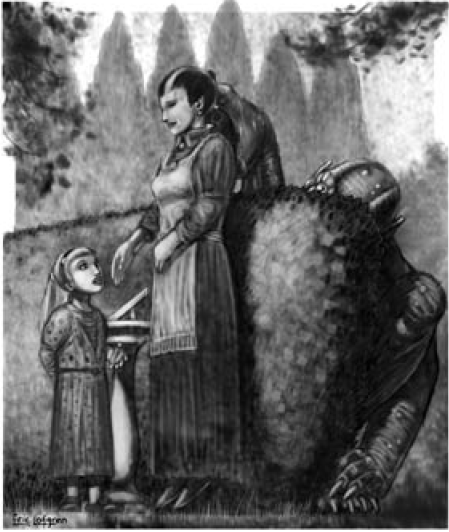
When monsters (and other inhabitants of Wonderland) burrow up to Chessboard One, they cast reflections of their own into our world. These reflections manifest in a variety of ways: “haunted” rooms, abandoned factories that look like they’re sprouting teeth until you get closer, subtly shifting graffiti, hobos, tanker trucks. Some monsters hang out on Chessboard One, devouring/torturing/mistreating the shadows of everyday folks. This leads to headaches, bad luck, and psychosomatic problems. Sometimes they’re up for something more personal.
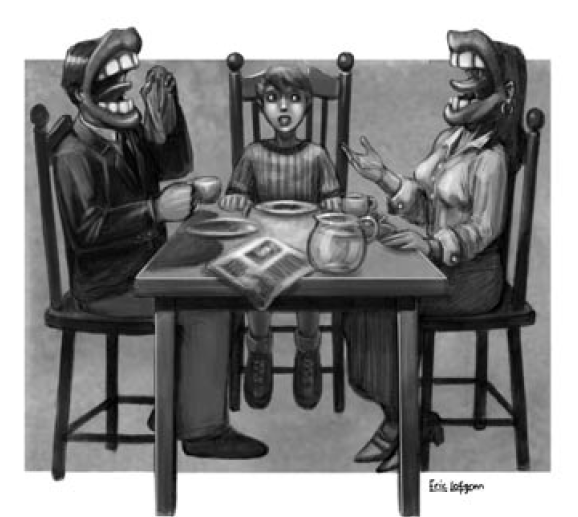
Whirls are one sort of creature that live on the lower chessboards. They’re shadows that’ve splintered off from a damaged human mind. For example, say I suffer a bout of life-changing, soul-crushing jealousy. The whirl-me branches off onto Chessboard One, tracks down the shadow of the person who wronged me, and does terrible things to their mind and body. The person’s shadow suffers grievously while the owner has a streak of bad luck.
Next, and without warning, we’re introduced to some game mastery advice about how to handle characters taking control of their Unsanity. “Since the evolution from victim to master is the core of many games,” Unsanity is an important mechanism in controlling the flow of horror. The more control players have, the less afraid they’ll be. If they can trigger/end episodes at will and be sure their shadow won’t get into trouble when it’s dragged topside, they’ll be a lot more willing to explore Wonderland. We still don’t rightly know what’s down there or why anyone would want to go deeper, but there’s probably something worth seeing.
Characters descend into Unsanity based on individual triggers (e.g. every time the phone rings), when they come into contact with artifacts of Wonderland, and just because. The .pdf provides notes about mechanics for measuring Unsanity and how to track it, but it’s wishy-washy about using them:
JAGS Wonderland posted:
Now we’re going to give you a bunch of "random roll" mechanics to handle Unsanity and Descent. At the same time, paradoxically, we are going to tell you that your group (and you have a say in this whether you are a player or a GM) may not want to use them […] Even in the canonical world of JAGS Wonderland these rules would only represent a practically non-existent “center of the bell curve."
It sounds to me like the writers don’t use these rules, but recognize that some gamers would see their lack as a problem. Anyway, I’m skipping them, except for the sorts of things you can do to tell your shadow to stop messing things up on Chessboard Zero.
Anti-depressants and alcohol! Not at the same time, ideally. Anything that mellows or numbs the body will make your shadow less responsive. You could also just tie yourself to a bed. In all cases though, it leaves your body restrained and unable to protect itself if terrible things are happening to it. It’s safer to have trusted friends watch you or leave Memento-style notes everywhere (e.g. “When I raise my voice, people think I am strange. I do not want people to think I am strange so I will not raise my voice.”
There’s also a table to roll on to see what kind of nasties notice that you’ve Descended and try to follow you back through the cracks in reality.
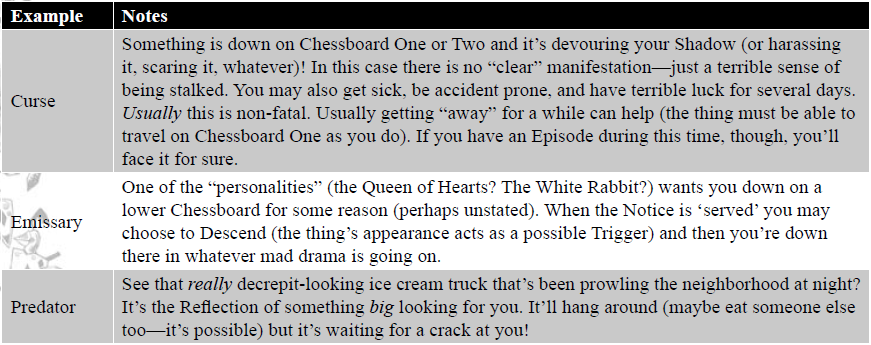
That ice cream truck isn't an example. It's reality.
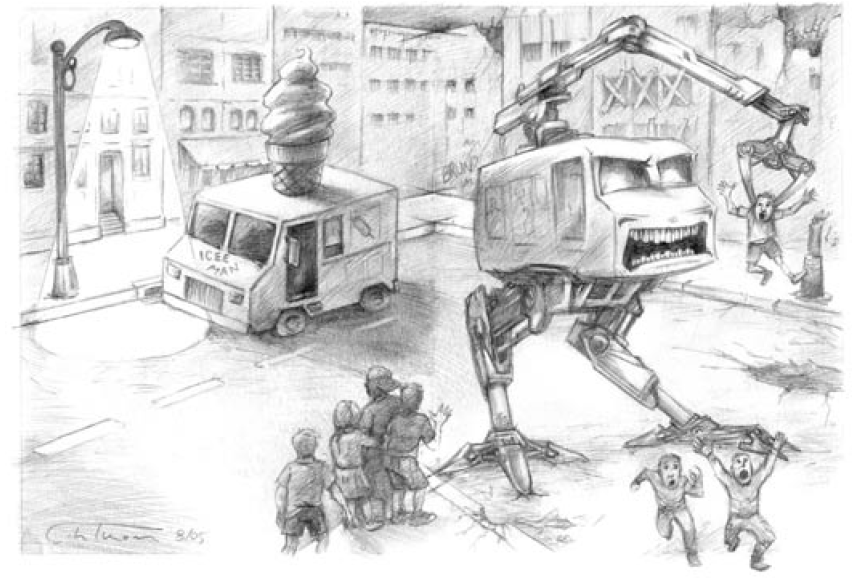
Enhance!
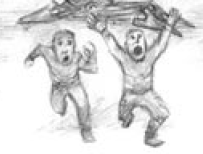
Enough beating around the bush! Next time, an in-depth look at Chessboards Zero-Six. Meet the Trash Children and the Orange Peel Men! This is where it goes off-the-hook (and why you’ll want to be a razor-limbed spaghetti creature.)
Not so little, not so Alice, now, are you?
Original SA post JAGS Wonderland: Not so little, not so Alice, now, are you?It's been a while since I've written anything about JAGS Wonderland. This is unforgivable. The collected back issues can be found here . Here's the recap: a hungry reality ("Wonderland") is bumping up against the everyday reality that we know. People who get too close end up infected with contagious madness. At this point, your options are "get eaten by shadow monsters," "get sucked into the depths of Wonderland," or "toughen up, develop strange powers, and take names." It's very 80's Grant Morrison by way of Neil Gaiman, which I mean in the best possible way.
Today we're delving into the different layers of existence between the "real" world (Chessboard Zero) and the realms beyond. Let's start with the Linear Maze , which is the "dark in-between which exists among the worlds." You get here by going behind or through something else: mirrors, cracks, strange doorways, archways, paintings, etc. Naturally, these openings don't show up for anyone who isn't undergoing Descent. It tends to look like cluttered back alleys, grand plazas, or a gradual breakdown of wherever the visitor entered. Alice's rabbit hole and the connections between worlds in Mirrormask are good examples.
The Linear Maze is inhabited by Looking Glass Makers, the sanitation workers and quantum mechanics of reality. These six-foot tall, bipedal machines "[seem] to have biological components." They're remote, refuse to communicate, and time warps around them. They can disassemble or assemble anything as a Short action. It is difficult to imagine any meaningful scene with a Looking Glass Maker.
Chessboard Zero is our world: "there's TiVo and The Onion and the Celtics are a basketball team and there are wars and inflation and music videos. Maybe you live here. Maybe you sometimes wish you didn't." Several factions on Chessboard Zero know about Wonderland. Their knowledge is imperfect and fragmented.
Project Pagan and Project Puritan are triple-secret government-ish agencies whose full history isn't revealed until later. Project Pagan wants a full-bore Wonderland incursion. Project Puritan wants to protect the status quo at all costs. The Underground, the folks who run the Cyclic Personality Disorder (AKA: Wonderland infection/unsanity) workshops want everyone to acknowledge and accept Wonderland, but unlike Project Pagan, they don't have Men in Black on their side.
In addition to these three groups, there's also corporate interest in Wonderland. "There is a certain precedent for large corporations to have, well, agents in Wonderland... and vice versa. Wonderland's fabric is very suspectible to the power of brand-names--of advertising iconography--of the inherent power of corporate logos." Contact with Wonderland is maintained through remote offices in the deeper layers of reality. They perform R&D in areas where physics are considered blasphemous and diversify their portfolios accordingly.
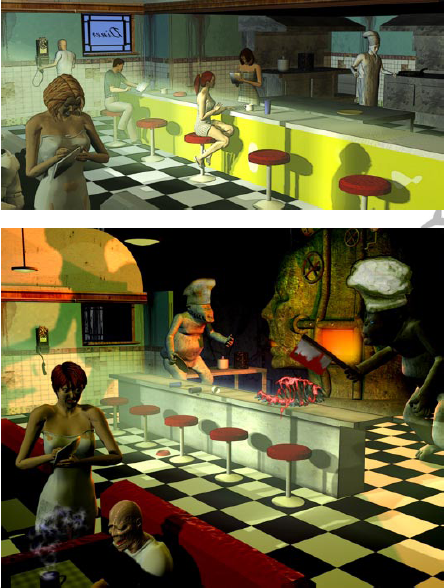
Take a trip down the nearest bleeding mirror, and you'll find yourself on Chessboard One. It's mostly the same as Chessboard Zero, with a few extra buildings and cul-de-sacs shoved in wherever they fit. Causal relationships tend to fall apart when visitors aren't looking, and one-in-a-few signs read like they're from They Live . Most of the inhabitants are Shadows of inhabitants of Chessboard Zero. They're exaggerated caricatures who pantomime their way through a grim mockery of life.
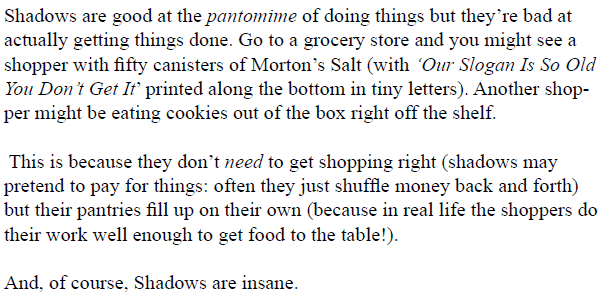
Some people have Mutant Shadows. These guys and ladies are physical manifestations of their Chessboard Zero counterparts' personalities. A needy girlfriend is a scary mosquito-lady; a brutal CEO is a brutal lion-man. When they maul a fellow Shadow, the damage is metaphorical on Chessboard Zero: the Shadow's owner is in a draining conversation or gets mauled in the boardroom. Visitors have no such protection.
Whirls are a special type of Mutant Shadow. They split off from their casters at some point, usually as the result of trauma or a difficult decision. They pursue their own agendas! Here are some examples:
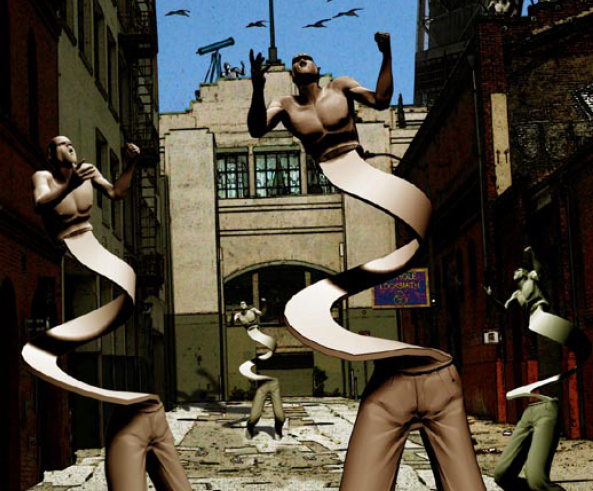
-
Confection Cooks
are "created are created when extremely jealous people have crippling bouts of fury at someone
getting away with something
. Their shadow swells, becoming fatter and fatter. The mouth collapses in, becoming an irregularly rimmed hole with a detachable jaw and random, jutting teeth." The cook vomits up a dirty apron and hat, and teams up with others of its kind. They use great bags of sand to create ironic confections. Anyone who eats the treat in Chessboard Zero suffers from a horrific, fairy tale fate (e.g. crushed by bookshelves for failing to return library books.) They inhabit ice cream trucks and kitchens.
-
Trash Children
are the personification of adolescent fad culture. They're kids made out of poppy garbage. They can briefly appear as real children on Chessboard Zero, which they do to make/abduct friends and gain new material goods. Trash children don't live very long because their gummy hearts are delicious and grant visions to the consumer.
-
Orange Peel Men
are what happens when a paranoid or schizophrenic person is betrayed. Their shadows just unwind into long, spooly dudes. Next, they band together, dress like government agents, and subvert whatever organizations they can into their grand conspiracy. "Designs may be things like extracting pieces of everyone in a given area's personality to build a bizarre crystalline construct of emotion and fractured motivations or, perhaps to keep people "in line" according to some strange scheme of conformity ("Tuesdays are Red Shirt Day"). The areas they inhabit start sprouting conspiracy paraphernalia like marked-up photos, and strange, half-encrypted files. Strong emotional stress causes them to unravel/explode.
-
Wyches
are Shadows of people who are angry they're feared instead of respected. Their hair becomes long, black, and crow-like. They can turn their arms into crow-wings. They travel in murders. They hang around parking lots and lure people down to Chessboard One to be eaten by monsters. They're even willing to teach you a little magic as long as it'll get you eaten by a monster quicker. An area infested with Wyches picks up "Gothic and Halloween trappings," like pumpkins and chalk drawing of ankhs.
-
InNetwork Physicians
are "the product of a therapist's psychological need to dominate a patient." When a therapist starts wishing a patient will get worse so he has more control over them (or a sweet paper topic), his Shadow could become a Whirl. They're standard-issue mad doctors that try to burrow into their hosts and hollow them out.
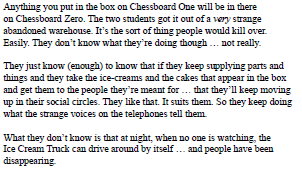
The chapter ends abruptly with a plot hook involving Confection Cooks and a spooky ice cream truck.
Next: The Mysteries of Chessboard Two
The Empty Places
Original SA post JAGS Wonderland: The Empty PlacesAnyone who still believes their Unsanity is just Cyclic Personality Disorder doesn't get past Chessboard Two . At this lay of intersecting realities, there are four types of terrain: sane, populated, warped, and abandoned. Areas of relative normalcy can exist close to nightmarish hellscapes.
Sane areas are just like Chessboard One. Abandoned areas are devoid of Shadows and their trashed. Everything's broken, lights flicker, and there's disturbing Graffiti (sic) on the walls. Warped areas "have become sick commentaries of themselves. Everything is shot through with madness-with-a-message, often making ironic, sometimes insightful commentary on Chessboard Zero reality."
That's a mighty promise to make, Chessboard Two. Can you live up to it? Let's take a look at the example of an everyday office building and how it looks through different lenses.
JAGS Wonderland posted:
Sane-Populated : The last cubicle on the row--the one where no one sits (in reality) has a mannequin in it that seems to be "typing." There's a computer there and it's writing a suicide note apologizing for shooting up the office building. It names you as part of its reason for "going postal." When you aren't looking, it moves around. It's dangerous. [...] [It] might be a sort of incarnation of the stresses that the office creates with its social atmosphere. It might also just be something dangerous that has moved in--you don't really know. [15% of the Chessboard]
Sane-Abandoned : The overhead lights, save for one, are off. Computer cases are broken open and coils of wire protrude. There's one computer screen on and it's doing a "web-tour" of horrific pornography sites that cater to your darkest fears as though they were desires. [Mannequin limbs everywhere. Dust storm outside, graffiti that may contain coded messages]
A big, jack-boted giant with gray skin and melted face thumps through the empty rooms carrying a giant cleaver. [Is the giant an embodiment of someone's "cutting remarks? Does the giant cause an atmosphere of cutting remarks?][70%. Welcome to Silent Hill.]
Warped-Abandoned : [As above, but the furniture is on the ceiling!] There are two staircases that come down from circular holes ringed with glyph-like corporate logos in the ceilings. Junk, massive collections of children's blocks fill the stairwells.
Big industrial dumpsters have been moved in too. They spawn dangerous crawling masses of medical waste. The gray giant is still here[.] [10%]
The windows are all "stained glass" and depict humiliating scenes from people's work lives (a few of them seem pointedly relevant to you!).
Warped-Populated : The Army of No fields mutant soldiers with a Nazi-like flair and they're quite dangerous to people who they encounter who aren't part of their "mission." (What is their mission? There's some notes on them in the final section.)
The floor [...] is done in the style of circus cars with clashing colors and designs and verical bars. The various sections (cells) say things like "See The Accountant" or "Watch the Analyst Work Long Hours!" Inside each car is a cubical with computer screen displaying strobe-light-bright flashes of mutated computer applications. There are chains and shackles and some Shadows sit at the desk, put to work (those people will be the most miserably oppressed on Chessboard Zero. [5%]
Other examples of meanings becoming overt on Chessboard Two are prisons (rusty cages connected to giant stone wheels that literally grind folks down and force them to conform to an expected shape) and HMO doctor's offices (a drive-thru fast food place with a broken conveyor belt.)
When newspapers fly by, it seems like they're trying to tell you something. Graffiti and torn-up movie posters are the same way. Usually, there's some sort of storm going on. Is this all a "part of the semitoic web that makes implied things actual"? Maybe! Is the human subconsciousness crafting a reality based on unease and the dawning madness of the observers? Or are greater forces at work here? What a ridiculous question! Let's talk about some of the inhabitants!
Enforcer Flowers show up when you do something on Chessboard Two that would break the law on Chessboard Zero. In other words, as you handle the flowers, your shadow deals with the real cops. Unless you tied him up or sedated him when you had the chance. This means that killing an Enforcer Flower may result in your Shadow killing a cop. However, it's more likely to be a metaphorical death.
Enforcer Flowers are quick-growing, giant yellow roses. After growing to man-sized, each one spits out a cop without a face. The upgraded versions have SWAT helmets, double-size naked teeth trapped in permanent, skinless smiles, and a combination of modern efficiency (rifles) and the older sort (balls-and-chains).
Believers are defined by their beliefs. These beliefs influence the surrounding area. Imagine people who inhabit a tiny diner and believe it's the best place to stay forever. You visit them for coffee and pie before leaving. It's several months later! Oh no! Or creepy, post-apocalyptic survivors scuttling through the 70% wasteland of the Chessboard. They believe there was a great war. Soon, toxic craters and disassembled war machines start cropping up in the wreckage around them. It isn't just that these people are crazy. Where did their beliefs come from in the first place?
The Army of No are mutants who dress like Nazis. They stage raids on Chessboard One to cause symbolic damage to Chessboard Zero. Why? That's covered elsewhere. This is an aggravating book sometimes.
The Monks of Mourning are horrific, whimpering monks. They observe Chessboard Zero by stalking people on Chessboard One. Then they make illuminated manuscripts about the minutiae of that person's life. Sometimes the monks will eat one of their own. Soon after, the monk's robes reinflate and it returns to work. They build monasteries.
The Fanfair is a gruesome parade of stretched, anorexic bodies. They play instruments, breathe fire, have mechanical jaws, etc. Sometimes they're led by someone who isn't an insane non-entity. Sometimes they carry cages and force others to be part of the parade. They're rumored to be humans who've gone permanently Unsane and trapped below. Until they're eaten.
Monster Families sound interesting. They're non-humans who work as shopkeepers like bakers or tailors. Why are they here? How do they sell bread to people like the Army of No and the Fanfair?
Coming up next, Chessboard Three: What are you pretending not to know?
What Are You Pretending Not to Know?
Original SA post JAGS Wonderland: What are You Pretending Not to Know?Chessboard Two is the dirty, infectious chaos; Chessboard Three is its manic, carnivalesque brother. "Lunacy has taken root in the terrain itself." Water flows upstream, heavily forested islands float through the air, and enormous monuments dot the fairy tale terrain. Gravity is Escher-like and localized. If you walk through the right door, you can find yourself walking up the side of a building. A running leap onto the same wall might orient your gravity to it, but it might not.
Major terrain features remain recognizable, but there's significantly more drift than at higher levels. Sometimes cities are replaced by ranges of gigantic grey headstones or a milk carton. "Iconic" cities (New York, Paris, Tokyo, the Prague?) are the seats of power, although the inhabitants are not like Chessboard Zero's.
The monuments magnify the message behind "meaningful" structures on Chessboard Zero. A shopping mall becomes an outright cathedral to corporate greed, with rough stone walls. A malpractice doctor's office becomes a haunted house of medical atrocities. Rock formations corkscrew upward into the sky, and fountains shoot music and light hundreds of feet into the air. Three-story statues to forgotten strangers stand above the land, unknown languages carved into their plinths. Look up their works, ye mighty.
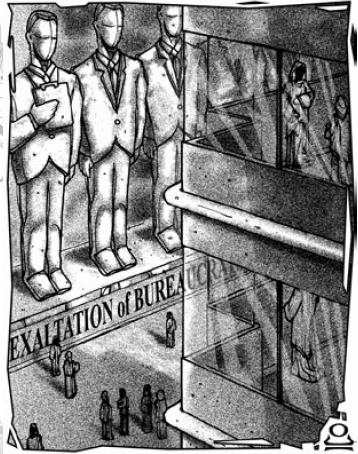
Areas of Chessboard Three are devoured by the Tulgy Wood. Rather than being described as an environment or a biome, it's referred to as a "recurrent meme [...] wild nature --a natural wood that encroaches on man-made domains." It starts here, and apparently, goes deeper. Sometimes it's beautiful, sometimes it's a twisted nightmare. It's large enough to house villages. Sometimes it appears where you least expect it, like the 11th floor of a skyscraper.
All of this madness is connected by roads: highways with signs marked with imaginary numbers, and railroads leading who knows where. Billboards throughout Chessboard Three encourage visitors to question knowledge and meaning: "What are you pretending not to know?" and "Your unspoken truth is your internal lie." Deep. They hint at the breakdown between signifier and signified: creating an image on Chessboard Three also creates the reality. A well-drawn pie can be scooped off the page and eaten. A sculpture of an adding machine can perform its intended function, as long as the sculptor has an idea of how it "should" work.
Who lives in wackyland?
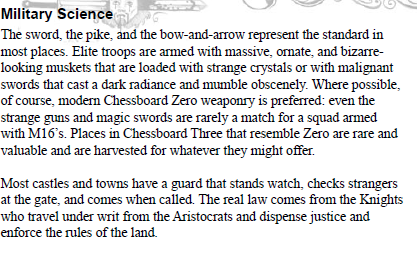
Serfs know that sticking their heads up is bad news. They live and die by ritual and their knowledge of the bizarre landscape. The middle class has gaslights, gunpowder, and Victorian morality. They spend their time working trades, most of which can be co-opted by a skilled enough artist. When not working, they worry about breaking social mores and becoming outcast. The aristocracy hold lavish parties and are frequently subject to curses and punishments like something out the Grimm Brothers.
The real power on Chessboard Three seems to be in the hands of distant, alien nobility who never visit their principalities. Their authority comes from "strange, cathedral-like castles, temples, and ruins scattered across the landscape." They pass strange laws (e.g. in one village, they use knotted string for currency.) Punch dolls and massive jack-in-the-boxes act as their enforcers. Will more be revealed in time? Probably!
Chessboard Three is also home to monsters. They have debates on the nature of monstrousness and their ideal societal role. Monsters are spontaneously generated ("Because nature abhors a vacuum," as a popular needlepoint work points out.) Monsters who eat humans begin to take human forms and mannerisms. This doesn't stop them from eating humans. We don't get any examples of monsters that are generated on Chessboard Three. Either they're in the sequel book, or we're just supposed to make something up that's sufficiently dragon/ogrey.
Coming up next, Chessboard Four: Out of the Hedge
Chessboard Four: Out of the Hedge
Original SA post
The end is near! I guess that means I should stop kicking my heels on
JAGS Wonderland
.
Remember, this is a world where an alien reality is bleeding over into the one that we know and love. As its mad, whimsical thoughts infect people, they get sucked down into lower levels of reality. Those who return from these "chessboards" often come back changed. Each layer of co-mingled reality is related to the world we know, although the connection becomes more tenuous as you descend down the rabbit hole. Also: monsters, conspiracy, etc.
JAGS Wonderland: Chessboard Four: Out of the Hedge
The landscape of
Chessboard Four
isn't content to stay still. Oceans form into mountains into jungles into deserts. Sometimes these transitions happen with the sort of regularity by which one can set a watch. Other times, it's anyone's guess. Why's everything so crazy?
quote:
There are no seas filled with mixtures of saline and water; there are oceans of doubt. The sediments--the ground you walk on--isn't ground silicon and aluminum oxides; it's 64% atmosphere, 17% tone with traces of of plot devices, influences, and faiths. In dangerous, volatile regions there are boiling fountains, raging storms, and devouring maelstroms of climax and resolution.
This is a plane of raw materials that give shape to the metaphorical truths on higher levels. These materials are known as deep elements. They're "naturally occurring," although the terminology doesn't instill a lot of confidence when reality's so tenuous. The chessboard's inhabitants mine the deep elements and trade them to higher levels.
-
Prison trees are trees made of black spikes and iron chains. Faces on them resemble unhappy, tormented people on Chessboard Zero. The trees have tentacles and try to eat people, but unwrapping the chain may help solve emotional problems high above. There aren't any mechanics for this. Like much of the setting material, it feels more like a suggestion than a rule. What are game rules anyway, man?
-
Wonder clouds are made of wonder and awe. Great cathedrals and works of art are hidden inside of them. Are the cathedrals and arts also made of clouds?

-
Mind mines are naturally occurring Mt. Rushmores. Cracking open the mountainous heads reveals crystalline deposits that can be mined given the right amount of rusty mine carts, lengthy shafts, and miners wearing lamp-helmets. Chopping up the crystals and inhaling them is mainlining pure inspiration.
-
The constellations of desire are needs and desires. They are neither "safe nor sane," but people talk to them and listen, nevertheless.
-
The Naught's vineyards are where human vices grow. They're watered with tears and blood and pressed into exquisite vintages. Who would be so cruel to drink such a brew? (The naughts!) Some vices are vague, others are specific (e.g. intellectual superiority, unwillingness to take responsibility.) Elsewhere in the chapter, smug superiority is mentioned.
-
True Love petals, which are grown in the Garden of Uden, can be crafted into ruby daggers. They're held together with an adhesive made of Jealousy and Nostalgia. If it's given as a gift to a lover, the dagger will hide in the lover's heart
until it's needed
. On higher Chessboards, it becomes an old postcard.
- Fortune takes the form of silvery spheres buried in sandy wastelands of Fate. Deal Breaker is an over-sized six-shooter made of ill fortune. It fires raw Bad Luck. On higher levels, it resembles a mirror that cracks as it "shoots." It "shoots by showing one's reflection," which means (as far as I can tell) you catch someone's reflection in the mirror and you've metaphorically shot them with Bad Luck--and literally shot their shadow with a gun.
Who can bear to live here?
Naughts are the primary inhabitants of Chessboard Four. They're people with smooth, round holes for heads. It's kind of like a skin Cheerio. They wear lifelike rubber masks and uniforms that identify their function in society, which generally relates to mining or shaping deep elements. They resent their lot in life, drink wine made of human vice, and offer dreams as sacrifice to... something on a lower level.
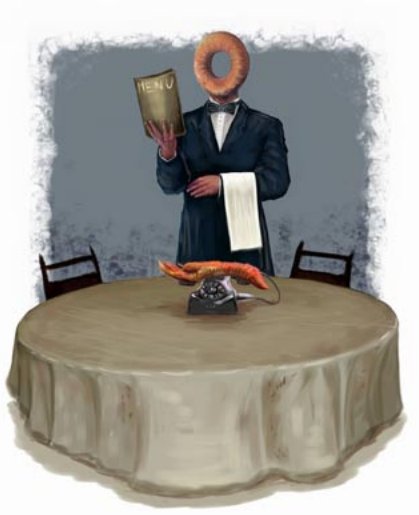
Naughts are "tailored" by special machines. They're jealous of humanity, who they alternately treat people like cattle to milk for emotions, "real boys" to jealously emulate, and dangerous subjects who they "ought to" show movies and radio plays cooked up in the Delusion Studios. They use radio towers to beam these delusions toward Chessboard Zero. Naughts live in small towns with neon, gasoline, a (small) cinema, convenience stores, etc. The shifting landscape makes mockery of any semblance of normal life. Other inhabitants of the Chessboard inclue:
-
Snarks (who live where sarcasm and intelligence flourish)
-
Wild Things (sentient avarice: birds of prey with luxury hood ornaments)
-
Trials (giants with angry eyes and hammers for heads) and Tribulations (Thwomps)
-
Moam Raths, Seduction, and Joy Whales.
... and this guy!
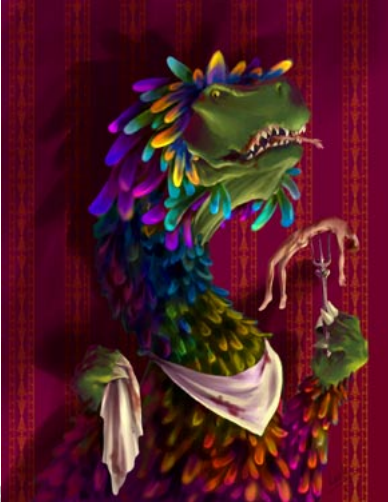
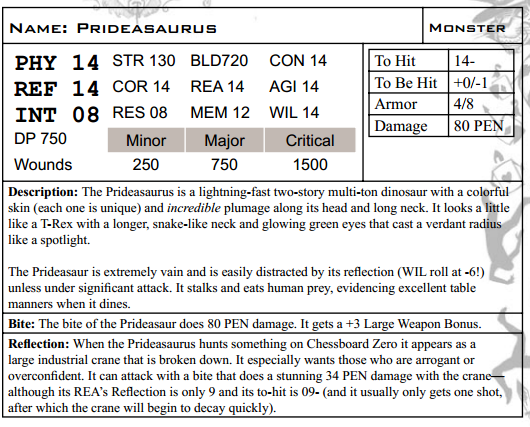
Coming up next, The Rest of 'Em ... at least until the Book of Knots lays bare all Wonderland's secrets.
The Rest of 'Em
Original SA post JAGS Wonderland: The Rest of 'EmAt this point, the .pdf grows coy. Everything beyond Chessboard Four is uncharted territory. It provides scraps of beautiful, scary imagery, but how much further can everything descend into madness? We're teased with "vast super-highways over void" and "oceans you can sail across to reach the moon," but no specifics. "Nothing is constant and nothing makes sense. This is Wonderland. This is where Alice went down the rabbit hole." Only, not literately. Not just literally. All of this misdirection makes fun a fun read, but a difficult summary. I'm just suggesting outside the diagetic frame of JAGS: Wonderland, Alice never had to deal with Prideasaurus.
We are told there are unknowable intelligences down here. The Red Queen. The Mad Hatter. The March Hare. They are "powerful and dangerous . Many an encounter with them has resulted in fates worse than death (or simply death)." These intelligences sit at the center of Dramas--what passes for society when all rules are in flux except for the Rule of Drama. Drama is overseen by the Drama Club. Somehow, the forces of Drama and the Drama Club conspire so there are always crises: plays in which travelers must take archetypal roles. "Every action a set-piece for someone ." Get too close to an Entity--"a thing which may have all the mercy of a guillotine and the comprehensibility of a dead language" and you're sucked into their Drama.
The section ends by offering more vague hints at what is yet to come (including the mysterious Chessboard Seven.) Without warning, the next chapter is about the effects of being Twisted, which I've previously covered.
Next up is a section on Society, the Mental Health System, and You . We get scraps of fiction (e-mails, press releases, bits of dialog) discussing Cyclic Personality Disorder, anarchist protestors from the Underground, and skeezy mental health professionals. We also get a chart from a secret government project that summarizes how many people have CPD/Wonderland Unsanity (about 1 in 25,000).
The Underground was mentioned previously, but they get a little more definition here. They're a support group in the AA mold. People talk about their feelings, keep an eye on one another, and agitate for political change. They're home to culture jammers, renegade psychiatrists, college students, iconoclasts, and mini-cults. From the amount of attention they get, it feels like the authors are pushing Underground-heavy campaigns.
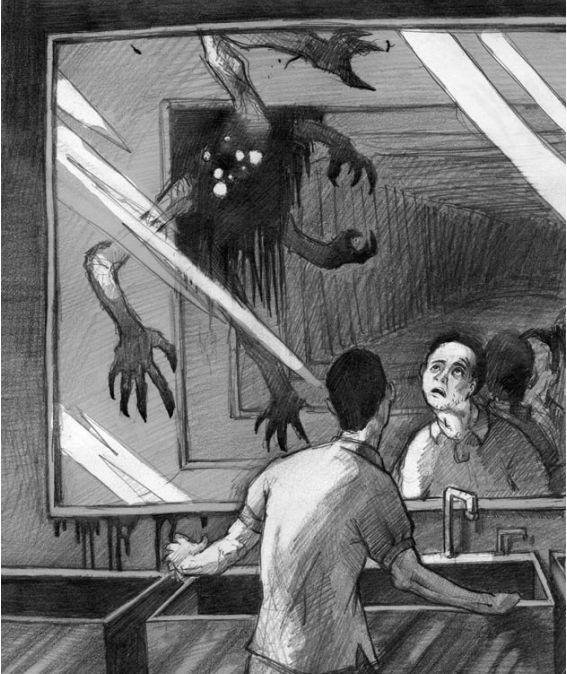
The Underground's big secret is their shadowy board of directors. Anyone who survives more than four years (or has large stacks of dollars) gets to know the information too dangerous for the rest of the flock: "the national or even international picture of what's going on with the Infection." But even they can't know too much, or they wouldn't be pushing the "don't believe in it and it can't hurt you" mantra. It's hinted that some of them have made foul bargains to protect themselves, while others are black magicians or Enlightened Hobos. The higher-ups respond to their knowledge of their lack of knowledge by acting especially shadowy and paranoid.
In general, the Underground feels like a crutch for experienced players to cast aside at the end of the campaign's first act. They've met the rest of the party at a support group meeting, rebelled against their vaguely sinister team leader, and run into the streets to shout, "Everything we know is wrong!" At night, the Prideasaurus comes.
This opinion is justified by the design notes, which occur immediately afterward: it creates conflict, it brings PCs together, it makes sense given the world they've set up, and it offers hope to the hopeless (even if it's a dangerous, false hope.)
Next, we get background information on the American mental health system, including basic layouts of mental health clinics, different types of mental health professionals, laws pertaining to mental health, and a smattering of unpleasant-sounding practices including electroshock therapy and lobotomies. Given the game's theme, this makes sense.
Now that we have 223 pages out of the way, let's conclude with the final chapter: Making the JAGS Wonderland Game . What's to be done with this hodgepodge of characters, settings, and situations?
First, we look at the starting power-level. This will be important later, when establishing themes. Is the game about "very capable college aged characters" or police detectives? The highest-level example seems strangely specific:
quote:
Two "super-spy" caliber characters who were both prisoners (one was a jewel thief, one was a deranged scientist). They were "recruited" and Infected because they were capable of averting a disaster on the lower levels of reality.
Next, we get three potential themes: the personal horror of going insane, escape (Wonderland is scary, but it's better than being another brick in the wall), and holding the line against unknowable odds. These brief descriptions lead into a description of two different types of horror games: the sort where the challenges can be unfair and meant to scare the players (Terror) and the sort where there are monsters and dark themes, but it's more about stopping these things and empowering the characters (Horror.) The .pdf includes some examples of each type of game and how one can bleed into the other. The section concludes with ways to tweak player empowerment: stronger characters will make them sure of themselves, while terrible complications from disassociation fugues will amp up scary loss of control.
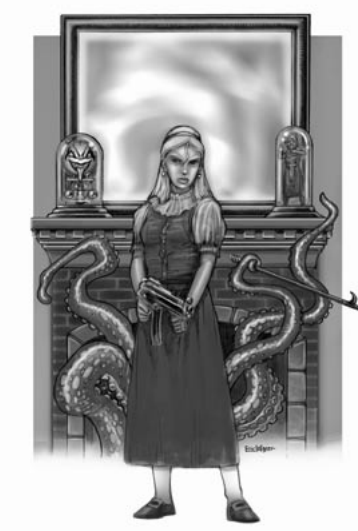
Neat! That's it. Book's over. Time to go home. Reflect. Recoup. Discuss. Plunder mercilessly for your next Changeling , Unknown Armies , or Don't Rest Your Head campaign. Prepare for all secrets to be revealed in the companion book, The Book of Knots !